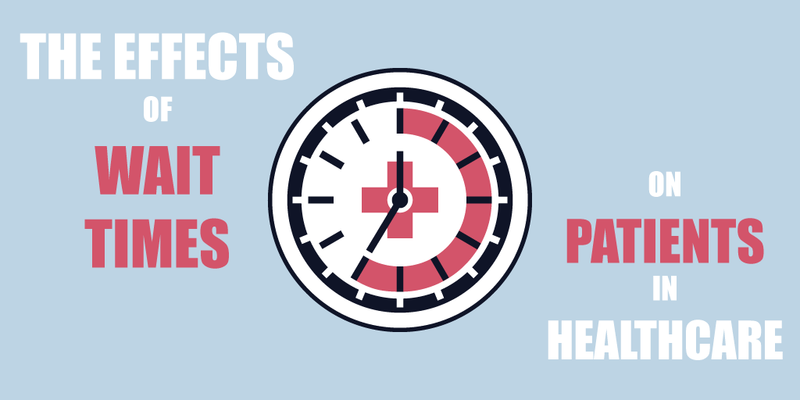In healthcare, there is no question of “Wait times: good or bad?”, there’s only a question of “How bad are they?”
Depending on which study you trust, the average time of your average patient waiting for a, hopefully not average, doctor can be around 18 minutes, 35 seconds. Those are the stats from 2017, and compared to the year before, there has been a decrease of 1 minute, 16 seconds.
Still, when you’re hurting, your perception of time is not exactly fine-tuned. The most obvious effect of long waiting in healthcare is that your patients need to, well, wait. But that’s not the only negative consequences of wait times in hospitals.
Unless you’re using queue management systems like Qminder, which you can try for free, you’re bound to see some of these effects happen to you.
The Drop in Satisfaction Scores

According to a study by healthcare consumer engagement group Vitals, the less patients wait, the better satisfaction scores. There is a strong correlation between wait times and doctors’ rating.
In the same study, physicians with five stars, which is the highest rating assigned within the study, had wait times that were over 20 minutes shorter than wait times of doctors with a one-star rating: 12 minutes, 33 seconds versus 33 minutes, 4 seconds.
Naturally, it might be argued that it’s the other way around — that wait times are the byproduct of poorly organized, less professional doctors. Mitch Rothschild, the Chairman of Vitals, believes the same, saying that “a doctor who can't watch the clock may not be effectively managing other parts of the practice that impact the patient experience."
There are also many different type of software for improving patient experience by automating paper work, check-in processes and empowering medical front-desks.
Perception of Care

Wait time affects how patients view the level of care they receive: 84% of patients say that reasonable wait time is somewhat or very important to a quality patient experience. In other words, the length of waiting is one of the parameters when measuring the level of care you receive.
The reason for that is that wait time is often considered a part of the “service package” rather than pre-service. As such, the longer a patient needs to wait, the worse is their outlook at the level of care they receive.
Long queues conjure up the image of mismanaged, poorly organized process — a far cry from a professional facility everyone hopes for when visiting their doctor for an appointment.
To minimize the risks of alienating their patients, hospitals need to understand the psychology of queuing.
Bonus: 25+ Best Patient Queuing Software
Financial Repercussions

There are also some negative financial consequences to mismanaging wait times in hospitals. Quite simply, patients don’t want to deal with hospitals that don’t respect their time.
30% of patients experiencing long wait times leave before seeing the doctor, and 20% change their healthcare providers altogether.
Following that, when patients don’t show up for their appointments, the financial consequences continue. To compensate for no-shows, some clinics and hospitals decide to double-book patient appointments — meaning that they give two patients the same time slot for an appointment.
Overbooking (adding more visits per day) and double-booking can lessen the impact of no-shows, but these practices are looked down at by medical experts as they also lead to patient backlogs, overworking your staff, and the decrease in quality of care.
The New England Journal of Medicine (NEJM) also points out that patients who cannot see their practitioner are more likely to succumb to desperation and choose an emergency room instead. This leads to overcrowding of emergency rooms, which means hospitals have fewer means to care for emergencies that happen after that.
Lastly, more than lost revenue, long wait times are also about missed opportunities. 20% of patients are willing to pay an extra fee for quicker service.
Wait Times Among Geriatric Patients

The Veterans Health Administration (VA) conducted a study on geriatric veteran patients. At the request of Congress, VA began measuring wait times way back in 1999.
The main finding is that since then, the wait times have dropped significantly. The data accumulated over the years has also allowed to gain insight into the consequences of long wait times for older patients with appointments.
The verdict was quite disheartening.
According to this study, patients aged 70 to 74 are almost 10 percent more likely to have a stroke when visiting facilities with longer wait times. At around 30 days of appointment wait time, older patients experience higher mortality rates and hospitalization.
Additionally, patients with diabetes are 2-4% percent less likely to use primary care when appointment wait times increased to three weeks.
In conclusion, for younger patients, wait times are a nuisance. For older patients, however, they are the matter of life and death.
The problem with wait times in healthcare is not that they exist, it's that they're actually easy to resolve. The most you need is a queue management system, after which your queuing process is set.





![The Ultimate Waiting Room Checklist: 65+ Ways to Enhance Your Space [PDF]](/static/img/cms-blog/9Nb3bvvnMqH4j9SnqQLtw/improve-waiting-room-checklist.png)
